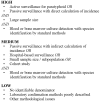Estimating the burden of paratyphoid a in Asia and Africa
- PMID: 24901439
- PMCID: PMC4046978
- DOI: 10.1371/journal.pntd.0002925
Estimating the burden of paratyphoid a in Asia and Africa
Abstract
Despite the increasing availability of typhoid vaccine in many regions, global estimates of mortality attributable to enteric fever appear stable. While both Salmonella enterica serovar Typhi (S. Typhi) and serovar Paratyphi (S. Paratyphi) cause enteric fever, limited data exist estimating the burden of S. Paratyphi, particularly in Asia and Africa. We performed a systematic review of both English and Chinese-language databases to estimate the regional burden of paratyphoid within Africa and Asia. Distinct from previous reviews of the topic, we have presented two separate measures of burden; both incidence and proportion of enteric fever attributable to paratyphoid. Included articles reported laboratory-confirmed Salmonella serovar classification, provided clear methods on sampling strategy, defined the age range of participants, and specified the time period of the study. A total of 64 full-text articles satisfied inclusion criteria and were included in the qualitative synthesis. Paratyphoid A was commonly identified as a cause of enteric fever throughout Asia. The highest incidence estimates in Asia came from China; four studies estimated incidence rates of over 150 cases/100,000 person-years. Paratyphoid A burden estimates from Africa were extremely limited and with the exception of Nigeria, few population or hospital-based studies from Africa reported significant Paratyphoid A burden. While significant gaps exist in the existing population-level estimates of paratyphoid burden in Asia and Africa, available data suggest that paratyphoid A is a significant cause of enteric fever in Asia. The high variability in documented incidence and proportion estimates of paratyphoid suggest considerable geospatial variability in the burden of paratyphoid fever. Additional efforts to monitor enteric fever at the population level will be necessary in order to accurately quantify the public health threat posed by S. Paratyphi A, and to improve the prevention and treatment of enteric fever.
Conflict of interest statement
I have read the journal's policy and have the following conflicts: RLO is employed by Sanofi Pasteur, a commercial company, as the lead for Dengue Epidemiological studies. This does not alter our adherence to all PLOS NTDs policies on sharing data and materials.
Figures
References
-
- Murray CJ, Vos T, Lozano R, Naghavi M, Flaxman AD, et al. (2012) Disability-adjusted life years (DALYs) for 291 diseases and injuries in 21 regions, 1990–2010: a systematic analysis for the Global Burden of Disease Study 2010. Lancet 380: 2197–2223. - PubMed
Publication types
MeSH terms
LinkOut - more resources
Full Text Sources
Other Literature Sources




